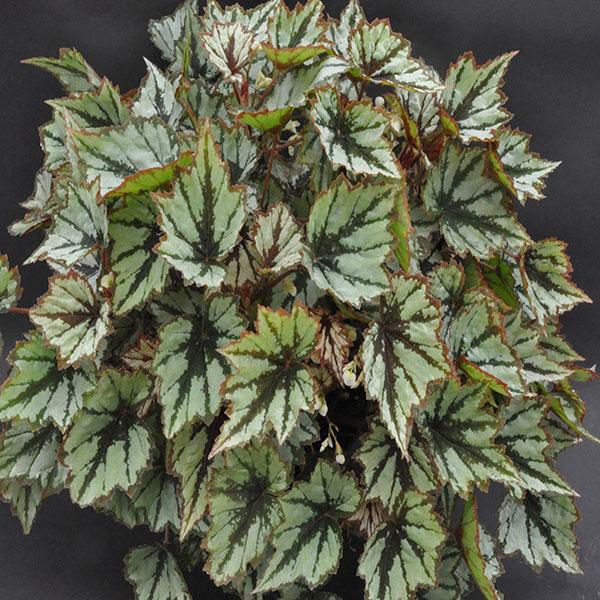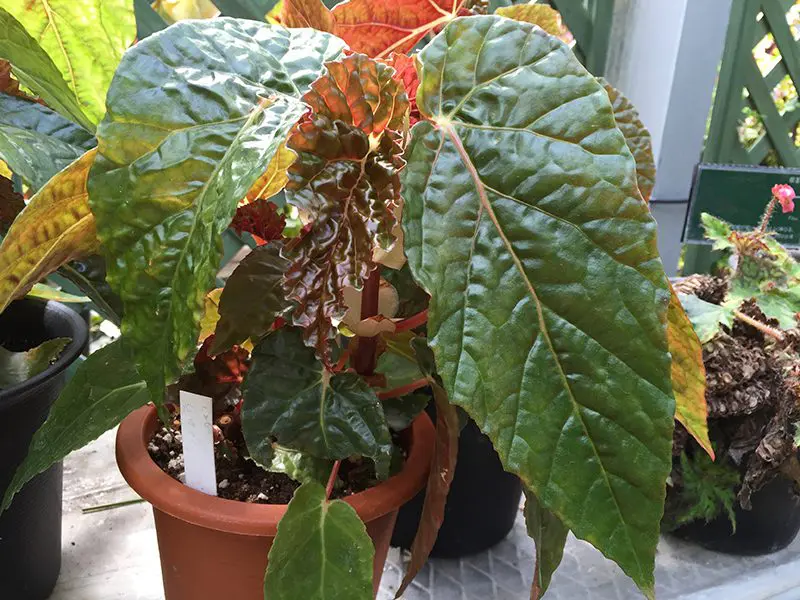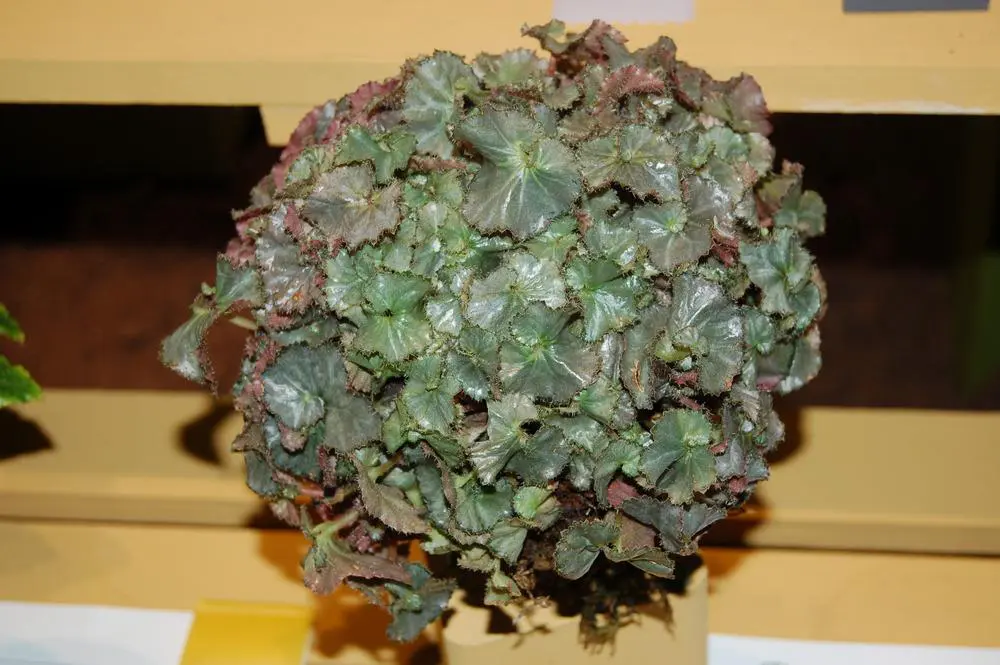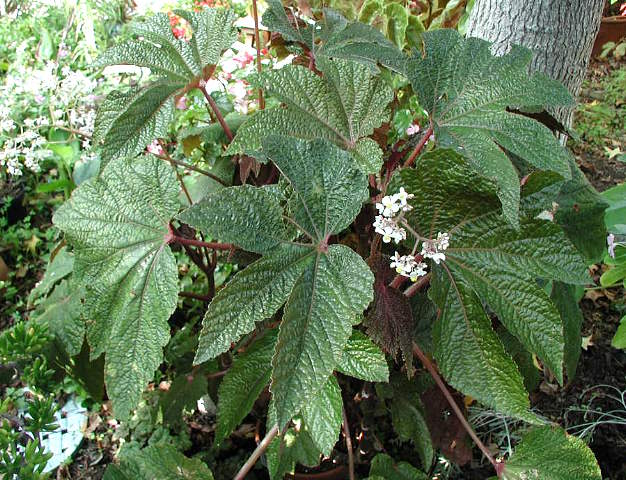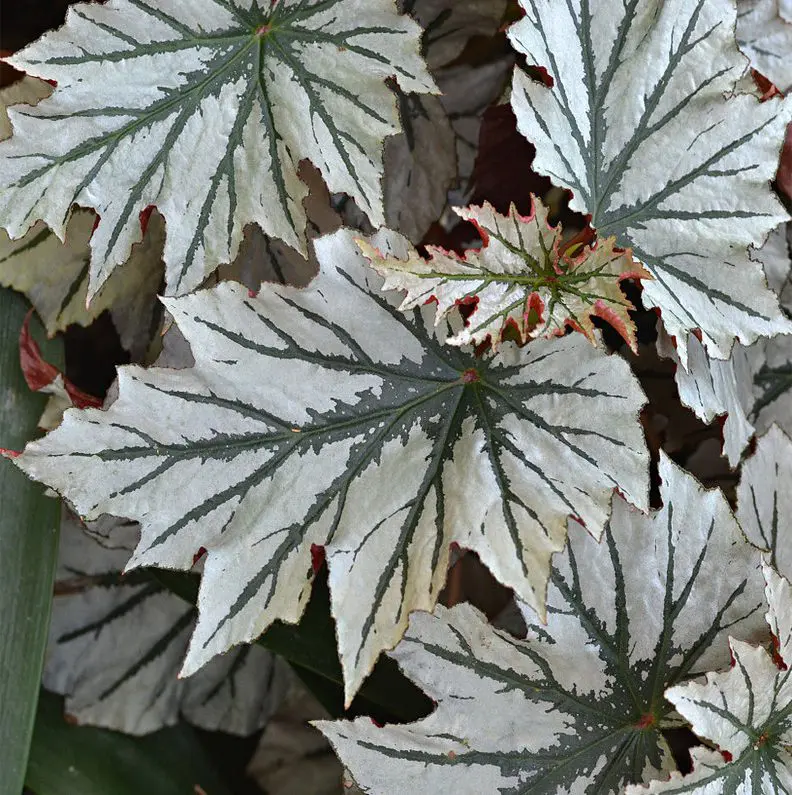
B. ‘Looking Glass’ bred by Patrick Worley (B. (Lana x Orpha C. Fox) × B. (Hannah Serr x Mandarin) )
by Patrick J. Worley
Part One
Hybridizing is more than just putting pollen to the stigma and planting the resulting seeds. Hybridizing can create new beauty and offers a challenge to even the most experienced grower. Anyone with the room to grow seedlings and time to watch them to maturity can become a hybridizer. The challenge comes with the selection of the parents and the eye and wisdom to determine what is worthy of further work. What is left must be relegated to the compost heap.
Everyone has a favorite technique for applying the pollen. I tap the pollen onto my fingernail and apply the pollen carefully and heavily to each of the three parts of the stigma. Others favor brushes to transfer the pollen. Care must be taken to insure that the pollen is cleaned from the brush between crosses. Alcohol is used to sterilize the brush and kill any unwanted pollen. The pollen can be taken up from the small porcelain or glass dish. A baby food jar, painted black was a favorite tool in Leslie Woodriff’s hybridizing work.
Pollen can also be deposited directly from the male flower, but unless the pollen is shedding and is viable after direct contact this method is less reliable.
I maintain a collection of dried pollen. I collect the pollen during the bloom season and place it on small folded sheets of clean white paper. When the pollen is thoroughly dry I fold up the paper, label it with the date and species or hybrid name and place it in a plastic box.
I use alphabetical file separators to organize the collection. I place the whole box in a large zip-locking bag and place it on the bottom shelf of my refrigerator until I am ready to use some of the pollen. Pollen saved this way can last up to a year or more.
The physical process of hybridizing couldn’t be easier: place the pollen from a male flower on the stigma of the female flower. The flowers of both must be ready, the stigma receptive, and the male shedding pollen.
B. ‘Lois Burks’ bred by Patrick Worley (B. ‘Mandarin’ × B. dregei )
B. ‘Gingersnap’ bred by Patrick Worley | Photo: Yoshitoyo Kondou.
B. ‘Dale Kramer’ (B. odeteiantha × B. gehrtii) | Photo: Yoshitoyo Kondou.
Planning a cross in advance allows us to be prepared to collect male flowers at maturity, hold them in a clean dry place and apply the pollen when the female parent is receptive. The female is receptive when the flower has fully opened and the stigma fully expanded, usually in the day after the flower first opens. There is often a glistening appearance to the stigma. The stigma remains receptive for up to a week, depending on the species, humidity, temperature, and light.
The male flower is ready when the pollen starts dropping from the stamen and is shed onto the surrounding area. In cases where we want to cross two different plants, we are often presented with a problem. Often the male flowers from one plant have all fallen and the females are receptive. In most new world Begonias, the males bloom first, drop away, then the females open. If the male flower is not present simply use the reserved dried pollen. In this way any cross that one has planned can be done when the female flower is ready.
I use tape to label the cross listing the female parent first and the date. I purchase a pink hair curl tape that is easy to write on, water tolerant and easy to see. I stick the tape to the peduncle so that if the ripe pod should fall I can find it and identify it.
If the cross is successful, the petals will fall within a few days and the ovary will swell. The process of ripening can take from weeks to months depending upon the plant. The pod is fully ripe when the peduncle dries and the pod is dried and has started to develop lesions or cracks. Care must be taken not to lose the seed. I place a small piece of paper, folded in half and then folded on one side, under the seed pod and strip it off with a small scissors so that I don’t lose the seed. I then fold the paper on all sides so the seed will not spill out and label it as to parentage.
New hybridizers often start by cross pollinating two open flowers. I call this proximity hybridizing; easy to do and unless planned a bit, it can result in thousands of nice, but not very interesting offspring.
The method that I use and recommend to would-be hybridizers is to study first the literature. Find out the parentage of your favorite Begonia hybrids. Start looking at begonias in books, in your own collection and see what features are available. Start a hybridizing program.
One must take small steps first to achieve an overall goal. An example of a modest plan would be to create a sturdy, compact, large flowered, deep red cane for windowsill growing. A long bloom cycle would be desirable. Set reasonable goals and select plants with features that fit into your plan. An everblooming plant with nice foliage and a compact plant with good habits could be crossed first.
Find two or three plants with desirable flowers and bloom season that fits your goals. By creating your own “stud plants” you can use the selected characteristics to create further crosses that advance your goal. Some name their plants that are appealing at each stage of hybridizing. As long as you select seedlings well this is one way to go about it. I tend to concentrate the features that I am seeking in a series of plants. Each, in its own way, contributes a known character to the offspring. By themselves, the “stud plants” or my stock plants may not be noteworthy, but when used in a cross they can give their unique traits, otherwise hidden, to the offspring.
By crossing two species one can create an F-1generation that is more or less uniform. In the next generation, the characters of the parents are combined in a very regular way with one half resembling the first generation and the rest a mixture of traits. This generation is where we select our first stud parents.
When we cross two hybrids, unless we know the parentage, the results are often like tossing dice. Some hidden, or recessive characteristics can come to the fore and we may get many surprises. We can select a desirable plant from the progeny and self-pollinate it, then select again the seedlings that have the habit we are seeking. Two very similar seedlings, crossed together, enhance and stabilize the trait we are seeking. For example, if two of the seedlings have compact habit and we throw in red flowers, some of the offspring will have compact habit and red flowers. Since it takes some study to find out if this trait is passed on, we can use this new selection as a check plant to give a compact habit, red color, and pleasing size.
In the next step we want to enlarge the flower size. We select a plant with known large flowers, red if possible, but pink or a red-based coloring if necessary. We perform the cross with our compact red, grow on the seedlings, which all may be tall with large and small red flowers. We back cross our largest flowered offspring to another large flowered seedling from the same cross to give us a next generation from which we can select our compact, red flowered, large flowered offspring.
Keeping some sort of written record is very helpful. One can also jot down what appear to be dominant and recessive characteristics for future work with these parents.
Part Two
The most important part of hybridizing is the selecting. Rather than naming every seedling it is necessary to test the seedlings. Next, make the selection. Time then to grit your teeth and throw away the leftovers.
What the world does not need is another look alike Begonia. The world does not need another Begonia name that will stay in the literature when the plant has been discarded as unworthy. The world does not need a plant that is beautiful to look at but impossible to grow under normal conditions. A six foot tall cane-like Begonia that requires a terrarium is unlikely to survive in cultivation.
The plant should be tested under different conditions, in a number of different areas of the county if possible. This gives the true measure of the plant.
I recall a story told to me by a great grower and friend, of a hybridizer who invited people over for a picnic. He had a table full of Begonia hybrids. Rex Begonias, I believe. The people at the party were told to go pick out a plant that they liked. My friend got “dregs”, one that was not very attractive, because she was there late. The plants were given the name of the person that picked the plant.
What is wrong with this scenario? The plants were not selected for beauty, strength, or distinctiveness. This was more of an ego satisfying show. My friend’s name was used on a Begonia, but one that she did not care for. Her name can never be used to honor a plant that is worthy. Many plant groups list hundreds, even thousands of hybrids. The reason for selecting and using your good taste to select from among hundreds or even thousands is the love of Begonia.
If it is worth the effort to grow on the seedlings, it is worth the trouble to select, grow, bloom, and test. If you just want some fill your garden, great. This may be a way to test a large number of plants. If you live where it is cold, you can simply bring in the plants that performed well and let the others die a natural death.
Semperflorens and Tuberous Begonias are grown by the millions. They are, however, still selected and named when a perfect color or specimen does show up. The plants are vegetatively propagated thereafter and a clonal name is maintained.
The key to making a good decision is to develop what I like to call “The EYE.” Here is a short list of things one can do to develop or improve the eye:
- Examine your favorite plants, species as well as hybrids. Ask yourself what it is about the plant that appeals to you. What makes it special? What makes it distinctive?
- Check your begonias especially those that are more commonly grown. Why are the older hybrids still being grown? Are they sturdier? Are they disease resistant?
- Are the plants easy to propagate and maintain? Are they being grown in many different areas? Are they often listed as carefree?
- Even though they may not be the most beautiful begonias, do they have characteristics that when combined make them special or distinctive?
- When compared to others of the group do they stand out in some way? Do they have features that make them instantly recognizable?
- When you look at a group of your seedlings is there one that catches your eye every time?
I have often done crosses that were new combinations, interesting and beautiful. They were weak, or over the long run turned out to be difficult to grow. I have done some amazing combinations that gave me stunning plants that just couldn’t make the cut. Some examples. I crossed B. versicolor with B. cinnabarina. The offspring showed both parents with gorgeous leaves and amazing orange flowers. The plant required terrarium care and after blooming it went dormant like a tuberous. It never again sprouted. I crossed B. gehrtii with B. venosa. The leaves were beautiful, but also so brittle. Just brushing against them would damage the leaves. Why give the world another heartbreaker of a plant that would just leave one with a handful of tattered chlorophyll?
If you manage to be strong and get rid of the extra plants, plants that don’t make the cut or are too similar, but inferior to your selection, you can move on to testing. I use people in different parts of the country. They grow and don’t tell. They test the plants under lights, in gardens, in bubble bowls or on window sills. I select people that can grow a good plant. This means they don’t have to baby a plant.
One thing that I like about begonias is ease of care. Your testers need to be honest, know many plants and be willing to toss out a plant. I mean really throw it away if you decide not to pursue it for any reason.
Don’t let anyone talk you into naming or releasing a plant that you have decided is inferior. If they make a good case you might think it over, but always ask the questions.
When you decide that you have a worthwhile plant, take it or send it with permission to someone who would like to grow it and distribute it. The reward comes when people grow the plants, love the plants, and they are passed around as something worth growing.
Every cross is not gold. Remember that you are on a journey. Not every stop is going to yield a nugget, but every stop will give you an experience. I have thrown out thousands of plants and hundreds of crosses. I have some crosses that still thrill me. I am not after numbers of named plants. I am after plants and hybrids that make me happy and delight my eyes.
If two plants from a cross look good, but not extremely different one could name both. Although some of the plants you don’t choose might be discarded, consider if there are features about sister seedlings that might contribute to future hybrids. This gives one an excuse to save a plant you just couldn’t throw out.
If you do decide to register the plant that you have found distinctive, remember to list the female parent first, male second. Make sure that your cross is a cross and not a self-pollination. Recognizing this can only come with experience. I have heard of crosses that I have also done that proved sterile and in fact are sterile. They are listed as parents of certain hybrids. Probably the female was accidentally self-pollinated.
Giving a plant a good and distinctive name is probably the difficult part for me. I try on different names and see how they fit. When in doubt, and I can’t seem to find a descriptive name, I will name it after a place, person or object that appeals to me.
Grow as many begonias as you can. If you pick a group, such as rhizomatous, familiarize yourself with the range of species and hybrids that are grown today.
I also suggest that you have fun. If you come up with something good and different, I will want it too! This may come off as too serious, that is not my intent. My intent is to encourage you to spend your time on something planned that can teach you about the plants. Learning about your plants makes them even more interesting to you. Growing is sharing! I love the surprises and I enjoy the thrill that I get when I look at beautiful Begonia. I have gained an appreciation of good hybridizing work and deepened my understanding of the species.
B. ‘Small Change’ bred by Patrick Worley (B. ‘Whiretta’ × B. ‘Royal Lustre’)
B. ‘Paul Hernandez’ bred by Patrick Worley (B. luxurians × B. gehrtii)
I decide what to cross based on what I would like to see. I won’t describe any of my ideas to anyone. I don’t talk about what I want to do. I do what I want to do. I fantasize then try to find ways to make it happen. I fail more often than I succeed, but when I do release a plant … I am proud of it.
Go forth and, selectively, multiply…
Small-leaved rhizomatous hybrids are much shought after and Patrick Worley’s B. ‘Small Change’, left, is one of them.
Patrick who hybridizes in Watsonville, CA has every right to be proud of such beauties as the distinctive B. ‘Looking Glass’ , B. ‘Paul Hernandez” and his many other great hybrids. This article first appeared in the newsletter of the Cascade Branch (OR).
Patrick Worley has developed some very unusual, as well as gorgeous hybrids such as B. ‘Paul Hernandez’ (B. luxurians x B. gehrtii).

